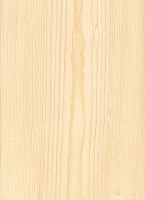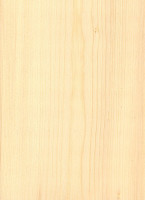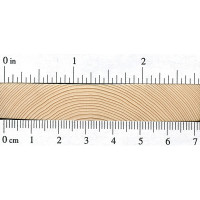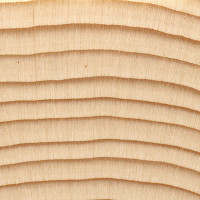 |
Common Name(s): Black Spruce Scientific Name: Picea mariana Distribution: Northern North America Tree Size: 30-50 ft (10-15 m) tall, 1-1.5 ft (.3-.5 m) trunk diameter Average Dried Weight: 28 lbs/ft3 (450 kg/m3) Specific Gravity (Basic, 12% MC): .38, .45 Janka Hardness: 520 lbf (2,320 N) Modulus of Rupture: 10,100 lbf/in2 (69.7 MPa) Elastic Modulus: 1,523,000 lbf/in2 (10.50 GPa) Crushing Strength: 5,410 lbf/in2 (37.3 MPa) Shrinkage: Radial: 4.1%, Tangential: 6.8%, Volumetric: 11.3%, T/R Ratio: 1.7 |
Color/Appearance: Black Spruce is typically a creamy white, with a hint of yellow.
Grain/Texture: Black Spruce has a fine, even texture, and a consistently straight grain.
Rot Resistance: Heartwood is rated as being slightly resistant to non-resistant to decay.
Workability: Easy to work, as long as there are no knots present. Glues and finishes well, though it can give poor (blotchy and inconsistent) results when being stained due to its closed pore structure. A sanding sealer, gel stain, or toner is recommended when coloring Spruce.
Odor: No characteristic odor.
Allergies/Toxicity: Although severe reactions are quite uncommon, Spruce in the Picea genus has been reported as a sensitizer. Usually most common reactions simply include skin irritation and/or respiratory disorders. See the articles Wood Allergies and Toxicity and Wood Dust Safety for more information.
Pricing/Availability: Construction grade spruce is cheap and easy to find. However, quartersawn clear pieces—free from knots—can be more expensive. Quartersawn billets of instrument-grade Black Spruce can easily exceed the cost of most all domestic hardwoods in terms of per board-foot cost.
Sustainability: This wood species is not listed in the CITES Appendices, and is reported by the IUCN as being a species of least concern.
Common Uses: Paper (pulpwood), construction lumber, millwork, and crates.
Comments: Black Spruce compares very similarly with Sitka Spruce in terms of mechanical properties, and is on average slightly heavier and stronger than Sitka Spruce. However, Black Spruce is a much smaller and narrower tree, and is not available in the same widths as Sitka Spruce.
 |
 |
 |
 |





Have you ever seen a conifer with wood grain like this? The forest laborers in the lower Himalayas call it “black rai” (rai is spruce), but they don’t have a very consistent way of codifying trees (for instance they don’t really distinguish spruce from fir once it is cut). I’m not sure whether it’s a distinct species or just a widespread case of blue stain. Beautiful stuff though! We’re going to make a few guitars with it.